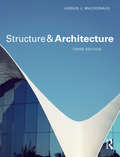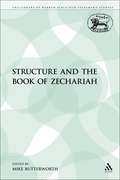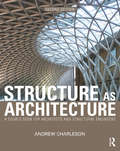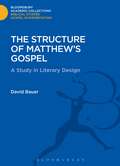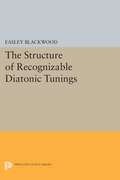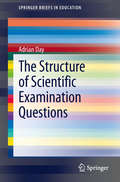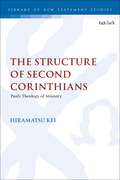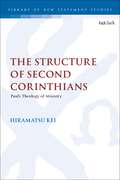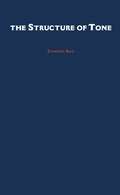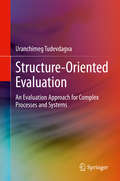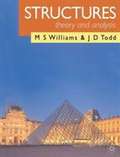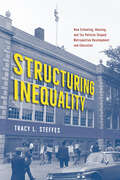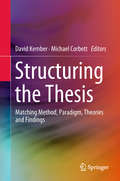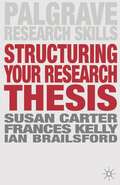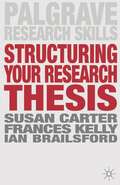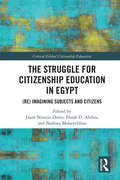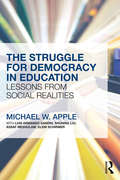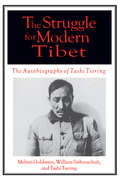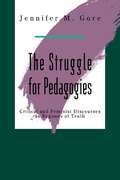- Table View
- List View
Structure and Architecture
by Angus J. MacdonaldThis thoroughly updated edition of Angus J. Macdonald’s insightful book Structure and Architecture offers an in depth analysis of structural design and its relationship with architecture. It draws on clear explanations of the connections between structural form, structural performance and architectural design to explore the interface between the technical and the visual in architecture. Additional chapters in this new edition cover the fields of structural theory, structural philosophy, the contributions of prominent engineers to the evolution of Modern architecture, and the concept and practice of sustainable design. Fully illustrated, this critical appraisal of structures is a core-curriculum text for students of architecture, structural engineering and architectural history, and is also a valuable resource for practitioners of these disciplines.
Structure and Architecture
by Angus J. MacdonaldThis thoroughly updated edition of Angus J. Macdonald’s insightful book Structure and Architecture offers an in depth analysis of structural design and its relationship with architecture. It draws on clear explanations of the connections between structural form, structural performance and architectural design to explore the interface between the technical and the visual in architecture. Additional chapters in this new edition cover the fields of structural theory, structural philosophy, the contributions of prominent engineers to the evolution of Modern architecture, and the concept and practice of sustainable design. Fully illustrated, this critical appraisal of structures is a core-curriculum text for students of architecture, structural engineering and architectural history, and is also a valuable resource for practitioners of these disciplines.
Structure and the Book of Zechariah (The Library of Hebrew Bible/Old Testament Studies)
by Mike ButterworthThis synthetic study has two primary tasks. The first is to elucidate the structure of the book of Zechariah. But in order to do this, a satisfactory method of analysis must be found. Thus the author begins by drawing up suitable literary criteria that will help to frame a reliable way of proceeding. The method is then tested on the book of Zechariah, and the results are compared with those of other biblical scholarship. Although this is a study in 'rhetorical criticism', it approaches the text from the standpoint of the authors' and redactors' intentions. The result is a convincing and wide-ranging analysis of the various and complex structural patterns of Zechariah.
Structure As Architecture: A Source Book for Architects and Structural Engineers
by Andrew CharlesonStructure as Architecture presents a comprehensive analysis of the indispensable role of structure in architecture. An exploration, as well as a celebration, of structure, the book draws on a series of design studies and case study examples to illustrate how structure can be employed to realize a wide range of concepts in contemporary architecture. By examining design principles that relate to both architecture and structural engineering, Andrew Charleson provides new insights into the relationship between both the technical and aesthetic aspects of architecture. Now in its second edition, the text has been extensively revised and updated throughout. Features include: A brand new chapter on hidden structure, adding to the material on exposed structures Two new chapters on using structure to realise common architectural concepts through a combination of precedents and creative design Over 50 new case studies from across the globe Easy-to-understand diagrams and a highly visual design to aid understanding and accessibility More than two hundred case studies of contemporary buildings from countries such as the UK, the US, France, Germany, Spain, Hong Kong, Australia and Japan illustrate how a thorough integration of structure adds layers of richness and enhances the realisation of architectural design concepts.
Structure As Architecture: A Source Book for Architects and Structural Engineers
by Andrew CharlesonStructure as Architecture presents a comprehensive analysis of the indispensable role of structure in architecture. An exploration, as well as a celebration, of structure, the book draws on a series of design studies and case study examples to illustrate how structure can be employed to realize a wide range of concepts in contemporary architecture. By examining design principles that relate to both architecture and structural engineering, Andrew Charleson provides new insights into the relationship between both the technical and aesthetic aspects of architecture. Now in its second edition, the text has been extensively revised and updated throughout. Features include: A brand new chapter on hidden structure, adding to the material on exposed structures Two new chapters on using structure to realise common architectural concepts through a combination of precedents and creative design Over 50 new case studies from across the globe Easy-to-understand diagrams and a highly visual design to aid understanding and accessibility More than two hundred case studies of contemporary buildings from countries such as the UK, the US, France, Germany, Spain, Hong Kong, Australia and Japan illustrate how a thorough integration of structure adds layers of richness and enhances the realisation of architectural design concepts.
The Structure of Matthew's Gospel: A Study in Literary Design (The Library of New Testament Studies)
by David BauerThis book addresses a central issue confronting the reader of the Gospel. Professor Bauer describes the impasse that has been reached in recent investigation of the structure of Matthew and demonstrates that an appreciation of literary design can provide a way forward. After identifying rhetorical features that relate to literary structure, he devotes the major part of his book to a systematic examination of such features as they appear in the Gospel in order to gain a fresh insight into the shape of the work. This study is valuable both for its comprehensive and judicious review of the question of structure in Matthew's Gospel and for the new direction which it establishes.
The Structure of Recognizable Diatonic Tunings
by Easley BlackwoodIn a comprehensive work with important implications for tuning theory and musicology, Easley Blackwood, a distinguished-composer, establishes a mathematical basis for the family of diatonic tunings generated by combinations of perfect fifths and octaves.Originally published in 1986.The Princeton Legacy Library uses the latest print-on-demand technology to again make available previously out-of-print books from the distinguished backlist of Princeton University Press. These editions preserve the original texts of these important books while presenting them in durable paperback and hardcover editions. The goal of the Princeton Legacy Library is to vastly increase access to the rich scholarly heritage found in the thousands of books published by Princeton University Press since its founding in 1905.
The Structure of Scientific Examination Questions (SpringerBriefs in Education)
by Adrian DayThis book shows how Systemic Functional Linguistics may be used to explore and explain the grammar of scientific examination questions. The author outlines the key elements of this theory and identifies problematical structures that affect the linguistic validity of such education assessment questions. This book also shows how examination questions may provide insight into the relationship between teaching and language in science.Do candidates give an incorrect answer because they do not understand the topic or because they do not understand the language by which the question is framed? This book shows how the analysis of scientific examination questions can answer this question.These chapters show how contemporary linguistics can inform the assessment of science and address topics including: the role of images, lexicography, the morphology of sentences, semantic discontinuity and the active reader.An example question is used throughout the text to illustrate the theories and each chapter has its own useful summary, making it a very readable work.
The Structure of Second Corinthians: Paul’s Theology of Ministry (The Library of New Testament Studies)
by Dr Kei HiramatsuHiramatsu Kei examines the literary structure of 2 Corinthians, and how it can illuminate our understanding of this Pauline letter and its intended message. He explores the theoretical foundations of Inductive Bible Study as an approach which focuses on the meaning of biblical passages to the original audience, and how this can inform meaning for readers today; while using readers' perceptions of the meaning of the biblical text in its final form as a starting point, he also prioritizes the literary context as consequential evidence for interpretation. Hiramatsu proposes that 2 Corinthians consists of seven major segments which coherently develop Paul's discourse pertaining to ministry, and he argues that there are two major components of the literary structure: the division of the letter into the seven parts and the identification of major structural relationships between the divided parts and the letter as a whole. He discusses the theological implications that arise from a literary investigation, illustrating that an inductive and integrative approach not only presents a more suitable and helpful literary structure for 2 Corinthians but also demonstrates the relevance of studying the literary structure when seeking to gain understanding of the theological implications of this Pauline letter.
The Structure of Second Corinthians: Paul’s Theology of Ministry (The Library of New Testament Studies)
by Dr Kei HiramatsuHiramatsu Kei examines the literary structure of 2 Corinthians, and how it can illuminate our understanding of this Pauline letter and its intended message. He explores the theoretical foundations of Inductive Bible Study as an approach which focuses on the meaning of biblical passages to the original audience, and how this can inform meaning for readers today; while using readers' perceptions of the meaning of the biblical text in its final form as a starting point, he also prioritizes the literary context as consequential evidence for interpretation. Hiramatsu proposes that 2 Corinthians consists of seven major segments which coherently develop Paul's discourse pertaining to ministry, and he argues that there are two major components of the literary structure: the division of the letter into the seven parts and the identification of major structural relationships between the divided parts and the letter as a whole. He discusses the theological implications that arise from a literary investigation, illustrating that an inductive and integrative approach not only presents a more suitable and helpful literary structure for 2 Corinthians but also demonstrates the relevance of studying the literary structure when seeking to gain understanding of the theological implications of this Pauline letter.
The Structure Of Tone
by Zhiming BaoThis book argues a fresh theory about the structure of tone. Bao investigates a wide range of tone sandhi data from various Chinese dialects and other Asian tone languages, providing empirical support for his proposal that tone is a formal entity which consists of register and contour. Bao establishes a clear typological distinction between register tone languages and contour tone languages whose contour tones have a more complex structure.
Structure-Oriented Evaluation: An Evaluation Approach for Complex Processes and Systems
by Uranchimeg TudevdagvaThis book introduces a new branch of evaluation theory, where evaluation and score calculation is embedded into general measure theory, as is typical in geometry, probability theory and reliability theory. The author describes the theoretical background of new evaluation model for complex processes, where interests of involved groups are considered as multi-players of evaluation process. Readers will learn how the logical structure of a process/system can be included into an evaluation. The author applies these techniques not only to the visualization of evaluation goals, but also the designed logical structure becomes the basis for calculation of evaluation scores. Various examples are provides to demonstrate the implementation of the methods.
Structures: Theory And Analysis (PDF)
by Martin Williams J. D. ToddA comprehensive textbook that encompasses the full range of material covered in undergraduate courses in Structures in departments of Civil and Mechanical Engineering. The approach taken aims to integrate a qualitative approach - looking at the physical reality of phenomena - with a quantitative approach - one that models the physical reality mathematically. An innovative introductory chapter looks at different types of structures - from the commonplace, such as chairs and aeroplanes, and the historically significant, such as the Pont du Gard in southern France, through to modern and novel structures such as the Bank of China building in Hong Kong - with a view to enthusing the reader into further study.
Structuring Inequality: How Schooling, Housing, and Tax Policies Shaped Metropolitan Development and Education
by Tracy L. SteffesHow inequality was forged, fought over, and forgotten through public policy in metropolitan Chicago. As in many American metropolitan areas, inequality in Chicagoland is visible in its neighborhoods. These inequalities are not inevitable, however. They have been constructed and deepened by public policies around housing, schooling, taxation, and local governance, including hidden state government policies. In Structuring Inequality, historian Tracy L. Steffes shows how metropolitan inequality in Chicagoland was structured, contested, and naturalized over time even as reformers tried to change it through school desegregation, affordable housing, and property tax reform. While these efforts had modest successes in the city and the suburbs, reformers faced significant resistance and counter-mobilization from affluent suburbanites, real estate developers, and other defenders of the status quo who defended inequality and reshaped the policy conversation about it. Grounded in comprehensive archival research and policy analysis, Structuring Inequality examines the history of Chicagoland’s established systems of inequality and provides perspective on the inequality we live with today.
Structuring Inequality: How Schooling, Housing, and Tax Policies Shaped Metropolitan Development and Education
by Tracy L. SteffesHow inequality was forged, fought over, and forgotten through public policy in metropolitan Chicago. As in many American metropolitan areas, inequality in Chicagoland is visible in its neighborhoods. These inequalities are not inevitable, however. They have been constructed and deepened by public policies around housing, schooling, taxation, and local governance, including hidden state government policies. In Structuring Inequality, historian Tracy L. Steffes shows how metropolitan inequality in Chicagoland was structured, contested, and naturalized over time even as reformers tried to change it through school desegregation, affordable housing, and property tax reform. While these efforts had modest successes in the city and the suburbs, reformers faced significant resistance and counter-mobilization from affluent suburbanites, real estate developers, and other defenders of the status quo who defended inequality and reshaped the policy conversation about it. Grounded in comprehensive archival research and policy analysis, Structuring Inequality examines the history of Chicagoland’s established systems of inequality and provides perspective on the inequality we live with today.
Structuring the Thesis: Matching Method, Paradigm, Theories and Findings
by David Kember Michael CorbettThe book is a collective investigation of the structuring of theses in education, the social sciences and other disciplines that commonly do not follow the standard procedures of the scientific method. To help research students design a structure for their own thesis and liberate their investigations from the constraints associated with the use of the conventional structure, it explains how the structures adopted were designed to suit the topic, methodology and paradigm. It also provides a wide range of examples to draw upon, which suit a broad spectrum of theory, methodological approaches, research methods and paradigms. Additionally, by analyzing the methodologies and paradigms, and reviewing the methodological and paradigmatic spectrum, it offers a significant contribution to the way research is conceptualized.The book addresses a number of key questions faced by students, supervisors and examiners: •Why do examiners often find it difficult to read work in non-scientific disciplines when theses are structured in accordance with the conventional scientific method?•Why do students in non-scientific disciplines struggle to write up the outcomes of their research in the conventional structure?•What alternative thesis structures can be devised to better suit the wide range of methods?•Which theories and paradigms are commonly followed in education and the social sciences and how do these perspectives influence the research process? •What methods, theories and paradigms are commonly adopted by education and social science students and what problems do these pose when students write their theses?
Structuring Your Research Thesis (Macmillan Research Skills)
by Susan Carter Frances Kelly Ian BrailsfordWritten in a lively and engaging style, this concise text helps students of all disciplines to structure their thesis in a clear, coherent and persuasive manner. It focuses on three core aspects of thesis structure and gives readers helpful guidance on ordering their ideas, making effective use of emphasis and achieving coherence in their writing. Enriched with insights from students and examiners, it shows students how to structure their thesis in a way that foregrounds the significance of their research.Packed with ideas for structuring theses effectively, this practical guide will be invaluable to thesis writers of all disciplines.
Structuring Your Research Thesis (Macmillan Research Skills)
by Susan Carter Frances Kelly Ian BrailsfordWritten in a lively and engaging style, this concise text helps students of all disciplines to structure their thesis in a clear, coherent and persuasive manner. It focuses on three core aspects of thesis structure and gives readers helpful guidance on ordering their ideas, making effective use of emphasis and achieving coherence in their writing. Enriched with insights from students and examiners, it shows students how to structure their thesis in a way that foregrounds the significance of their research.Packed with ideas for structuring theses effectively, this practical guide will be invaluable to thesis writers of all disciplines.
The Struggle for Citizenship Education in Egypt: (Re)Imagining Subjects and Citizens (Critical Global Citizenship Education)
by Jason Nunzio Dorio Ehaab D. Abdou Nashwa MoheyeldineThis book offers nuanced analyses of the narratives, spaces, and forms of citizenship education prior to and during the aftermath of the January 2011 Egyptian Revolution. To explore the dynamics shaping citizenship education during this significant socio-political transition, this edited volume brings together established and emerging researchers from multiple disciplines, perspectives, and geographic locations. By highlighting the impacts of recent transitions on perceptions of citizenship and citizenship education in Egypt, this volume demonstrates that the critical developments in Egypt’s schools, universities, and other non-formal and informal spaces of education, have not been isolated from local, national, and global debates around meanings of citizenship.
The Struggle for Citizenship Education in Egypt: (Re)Imagining Subjects and Citizens (Critical Global Citizenship Education)
by Jason Nunzio Dorio Ehaab D. Abdou Nashwa MoheyeldineThis book offers nuanced analyses of the narratives, spaces, and forms of citizenship education prior to and during the aftermath of the January 2011 Egyptian Revolution. To explore the dynamics shaping citizenship education during this significant socio-political transition, this edited volume brings together established and emerging researchers from multiple disciplines, perspectives, and geographic locations. By highlighting the impacts of recent transitions on perceptions of citizenship and citizenship education in Egypt, this volume demonstrates that the critical developments in Egypt’s schools, universities, and other non-formal and informal spaces of education, have not been isolated from local, national, and global debates around meanings of citizenship.
The Struggle for Democracy in Education: Lessons from Social Realities
by Michael W. AppleThe Struggle for Democracy in Education extends the insightful arguments Michael W. Apple provided in Can Education Change Society? It provides detailed examinations of both local and system-wide struggles around conflicting versions of democracy. Grounded in a key set of ethical and political responsibilities for those who care deeply about education, Apple and his co-authors interrogate conflicting models of democratic education, one interested in the common good and the creation of critical citizens, the other market-oriented and meant to meet a set of more conservative economic needs. Through a series of powerful international case studies, this volume explores the contested terrain, combining powerful theory with the "stuff" of schools, political and pedagogical actions, and the lives of individuals. These detailed examinations provide the reader with a more nuanced understanding of how policy, history, and varied actors with varied agendas come together, and the very real people and systems that are impacted by these conflicts. The Struggle for Democracy in Education asks us to face and understand these myriad forces and actors—both progressive and retrogressive—and to ask what we can do to ensure that the education that is created is worthy of its name. In the process, the book gives us real examples of critically democratic education and what we can learn from these struggles.
The Struggle for Democracy in Education: Lessons from Social Realities
by Michael W. AppleThe Struggle for Democracy in Education extends the insightful arguments Michael W. Apple provided in Can Education Change Society? It provides detailed examinations of both local and system-wide struggles around conflicting versions of democracy. Grounded in a key set of ethical and political responsibilities for those who care deeply about education, Apple and his co-authors interrogate conflicting models of democratic education, one interested in the common good and the creation of critical citizens, the other market-oriented and meant to meet a set of more conservative economic needs. Through a series of powerful international case studies, this volume explores the contested terrain, combining powerful theory with the "stuff" of schools, political and pedagogical actions, and the lives of individuals. These detailed examinations provide the reader with a more nuanced understanding of how policy, history, and varied actors with varied agendas come together, and the very real people and systems that are impacted by these conflicts. The Struggle for Democracy in Education asks us to face and understand these myriad forces and actors—both progressive and retrogressive—and to ask what we can do to ensure that the education that is created is worthy of its name. In the process, the book gives us real examples of critically democratic education and what we can learn from these struggles.
The Struggle for Modern Tibet: The Autobiography of Tashi Tsering
by Melvyn C. Goldstein William R Siebenschuh Tashi TseringThis captivating autobiography by a Tibetan educator and former political prisoner is full of twists and turns. Born in 1929 in a Tibetan village, Tsering developed a strong dislike of his country's theocratic ruling elite. As a 13-year-old member of the Dalai Lama's personal dance troupe, he was frequently whipped or beaten by teachers for minor infractions. A heterosexual, he escaped by becoming a drombo, or homosexual passive partner and sex-toy, for a well-connected monk. After studying at the University of Washington, he returned to Chinese-occupied Tibet in 1964, convinced that Tibet could become a modernized society based on socialist, egalitarian principles only through cooperation with the Chinese. Denounced as a 'counterrevolutionary' during Mao's Cultural Revolution, he was arrested in 1967 and spent six years in prison or doing forced labor in China. Officially exonerated in 1978, Tsering became a professor of English at Tibet University in Lhasa. He now raises funds to build schools in Tibet's villages, emphasizing Tibetan language and culture.
The Struggle for Modern Tibet: The Autobiography of Tashi Tsering (Mellen Studies In Education Ser. #Vol. 88)
by Melvyn C. Goldstein William R Siebenschuh Tashi TseringThis captivating autobiography by a Tibetan educator and former political prisoner is full of twists and turns. Born in 1929 in a Tibetan village, Tsering developed a strong dislike of his country's theocratic ruling elite. As a 13-year-old member of the Dalai Lama's personal dance troupe, he was frequently whipped or beaten by teachers for minor infractions. A heterosexual, he escaped by becoming a drombo, or homosexual passive partner and sex-toy, for a well-connected monk. After studying at the University of Washington, he returned to Chinese-occupied Tibet in 1964, convinced that Tibet could become a modernized society based on socialist, egalitarian principles only through cooperation with the Chinese. Denounced as a 'counterrevolutionary' during Mao's Cultural Revolution, he was arrested in 1967 and spent six years in prison or doing forced labor in China. Officially exonerated in 1978, Tsering became a professor of English at Tibet University in Lhasa. He now raises funds to build schools in Tibet's villages, emphasizing Tibetan language and culture.
The Struggle For Pedagogies
by Jennifer GoreFirst Published in 1993. Routledge is an imprint of Taylor & Francis, an informa company.
